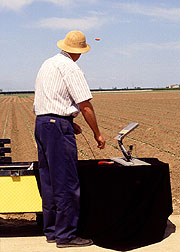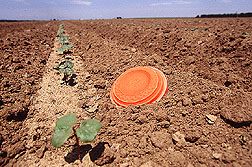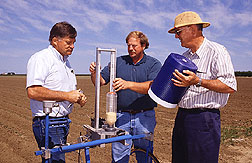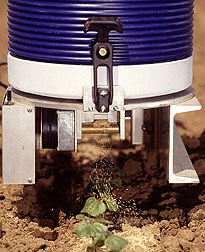Bugslinger!
|
|
Bugslinger! Flings Biocontrols Where You Want 'Em!
Coming soon to a farm near you: six- and eight-legged creatures that arrive in flying saucers and fan out to devour or otherwise demolish their living prey...cotton aphids and other farm pests.
The craft isn't a spaceship. It's the Bugslinger, or Aerodynamic Transport Body, one of two new devices to help farmers deploy beneficial, pest-killing insects and mites to exactly where they're needed in fields.
The new devices do this more quickly, easily, and economically than others tested by the scientists. Bugslinger, or ATB, and its partner in biocontrol, the Mite Meter, should boost the use of good bugs and reduce growers' reliance on chemicals.
Agricultural engineer Lyle M. Carter and his Agricultural Research Service colleagues in California invented the devices for strategically scattering the beneficial insects. They are currently testing and refining both the Mite Meter and the ATB.
Carter, agricultural engineer Joseph H. Chesson, and machinist John V. Penner are based at ARS' Western Integrated Cropping Systems Research Unit in Shafter. They're seeking a patent for the ATB. It's an innovative modification of targets used in skeet or trap shooting. The beneficial organisms --which are either predators or parasites of crop-destroying insects --travel in a lightweight, disk-shaped container launched from the edge of the field. The disk has a suitably sized exit for the beneficials to use once their mothership lands.
"Right now,"says Carter, "we're working with a disk made of powdered limestone that's about 4 inches in diameter and 1 inch high. But disks could also be made of materials that degrade faster, such as paper, oatmeal, tree bark, alfalfa hay, compacted fertilizer pellets --or even compressed peat moss like that used for nursery pots. Any of these alternative containers,"he says, "will deteriorate naturally after a few rains or after the field is irrigated a few times."
A Big Fling
The researchers' tests show that even the delicate biocontrol wasp Aphelinus nr. paramali survives the disk's 110 mile-per-hour speed and 175G rotational force. The Aphelinus wasps attack cotton aphids, a pest that also carries the costly citrus tristeza virus.
The ATB launcher can be mounted on a truck, tractor, or all-terrain vehicle that would travel along field roads, slinging saucers as it goes.
"That's much faster than manually placing containers of biocontrol agents near plants,"notes Carter, "and is comparable in application time to ground spraying of insecticides."Though any beneficial insect or mite is a candidate for this special shuttle service, it seems best suited for use with adult predators or adult parasites that can quickly fly away from the container.
Because the launching device operates from the perimeter of a field, it reduces the number of times workers would otherwise need to enter the property. This lowers labor costs, reduces soil compaction after rain or irrigation, and helps thwart the inadvertent spread of weed seeds and pests that can cling to clothing or machinery.
Bombs Away!
If the ATB is a catapult, the Mite Meter is a gentle bomber that efficiently and precisely dispenses predatory mites or other beneficials.
The Mite Meter may boost use of these commercially available predators by cotton growers, who don't yet generally rely much on the tiny but hard-working helpers.
The prototype Mite Meter consists of a small, chilled holding tank for the biocontrols. They rest within vermiculite, corn grits, or other carrier material. A tiny gate dispenses precise amounts of the mite-and-carrier mix onto a narrow conveyor belt. The belt's speed is adjustable with a small electric motor. On reaching the end of the belt, the mixture falls to the ground.
The Mite Meter can be attached to a tractor to dispense 500 to 20,000 mites per acre across as many as 10 acres in an hour.
Carter and co-researchers at Shafter tested the prototype with western occidental mites, Galendromus occidentalis, and big-eyed bugs, Geocoris punctipes. Both of these predators eat Pacific spider mites, strawberry mites, and two-spotted mites. The big-eyed bug attacks additional pests in cotton and other crops, as well.
In outdoor tests, more than 95 percent of the beneficial mites and big-eyed bugs survived a trip through the Mite Meter. The apparatus can't ferry beneficial wasps, however, because they are too fragile.
Carter says the prototype Mite Meter is superior to many other devices for applying beneficials because of speed, precision, and high survival rate of mites. Too, the meter enables growers to use mites straight from the box, that is, the shipping container from the insectary where the mites were raised.
Much of Mite Meter's precision is owed to the design of its tank. An inner, 1.5-liter bottle --like the kind soft drinks are sold in --fits into an insulated jug. The jug is kept frozen when not in use.
Says Carter, "Keeping the mites cool and comfortable is critical. Otherwise, they move around quickly in the tank, generally upward and away from the gate and metering belt. That means your application rate might be too low at the beginning of the run and too high at the end. You'd have to buy extra mites to make up for the inconsistent distribution."
|
|
Some mite applicators require further diluting of an insectary's mite-and-carrier mixture. Typically, insectaries ship predaceous mites in concentrations of from 1,000 to 20,000 mites per one-quarter to 1 cup of carrier.
With the Meter, there's no need to buy and mix any extra carrier. That means there's no increased risk of accidentally killing some of the mites. Otherwise, the longer the mix is tumbled, the greater the number of mites that are inadvertently killed.
Both the Mite Meter and the ATB should give commercial insectaries the option to provide customers with preloaded containers of beneficials that can be taken directly to the field and dispensed.
"With the Mite Meter," Carter points out, "you're working with a small volume of mixture, instead of a lot of bulky carrier. Because you're applying the mites at insectary concentrations, you only need to refill the tank every 2 hours or so. And you don't need to stop to re-cool the material. We estimate that all these advantages might add up to a cost savings of about 30 to 50 percent over other approaches." --By Marcia Wood, Agricultural Research Service Information Staff.
For more information on patent application number 08/933,124, "Aerodynamic Transport Body for Distribution of Biological Agents,"or on the Mite Meter, contact Lyle M. Carter, USDA-ARS Western Integrated Cropping Systems Research Unit, 17053 N. Shafter Ave., Shafter, CA 93263; phone (805) 746-8004, fax (805) 746-1619.
"Bugslinger! Flings Biocontrols Where You Want 'Em" was published in the August 1998 issue of Agricultural Research magazine. Click here to see this issue's table of contents.










